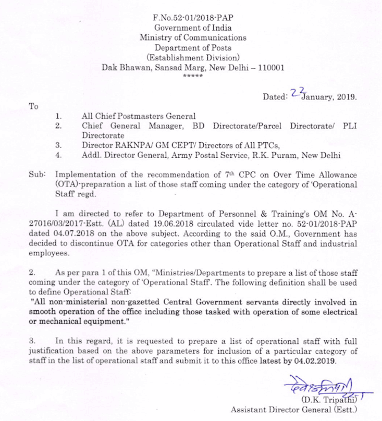Allowances Proposed by NC JCM Staff Side to 7th Pay Commission in its memorandum has been justified by citing various factors.
The following is the proposal of NCJCM Staff Side in respect of Allowances like Dearness Allowance, House Rent Allowance, Compensatory City Allowance and Transport Allowance which has been submitted to 7th Pay Commission. Staff side defended that HRA to be doubled from the existing rates since the Rents of accommodation is increased exorbitantly. Its Justification for increasing allowances is provided in the memorandum. It is reproduced here for readers reference..
Dearness allowance.
The neutralisation envisaged under the present computation of dearness compensation is supposed to be cent per cent, but in reality it is not the case. Actual consumer price index is much higher than the level at which DA is calculated on the basis of 12 monthly average. The average is always lower than the actual cost of living.
15.1.2. The calculation of consumer price index, its basis, the basket of goods on which it is based, are questionable and has become a matter of dispute. Since the Pay Commission being not the forum at which these issues could be taken, we do not propose to go into the details of this aspects.
READ ALSO : 7th Pay Commission Minimum Wage should be Rs.26000 – NCJCMs Justification
15.1.3 We suggest, therefore, that the existing formula of computation of DA and its payment with effect from 1st January, and 1st July, may continue.
House Rent allowance(HRA)
The present scheme of HRA is based on the recommendation of the 6th CPC, which is as follows:
| The present scheme of HRA is based on the recommendation of the 6th CPC, which is as follows: Population criteria | classification | Rate as a % of pay + Grade Pay + MSP +NPA |
| 50 lakhs and above | X | 30% |
| 50 to 5 lakhs | Y | 20% |
| Below 5 lakhs | Z | 10% |
15.2.2. We reproduce hereunder the recommendation made by the third Central Pay Commission in the matter of grant of house rent allowance. (Para 29 Part I. Vol. IV.Chapter 56), which would be the best if implemented even today.
“While we find it difficult to accept the kind of parity suggested above, we are aware of the acute problem caused by the lack of adequate government housing and by the inadequate government housing and by the inadequacy of the existing rates of house rent allowance and recommend as follows:-
(i) Government should take houses on long lease and make residential accommodation available to its employees on payment of 10% of their pay.
(ii) Government should lay down appropriate house rent allowance rates in different cities and towns based not on population criteria, but on an actual assessment of the prevailing levels of rent in different cities and towns. Alternatively, certain notional rents for different types of accommodation meant for officers and personnel of specified pay groups should be laid down for particular cities after studying the actual conditions in that city. The difference between the actual rent paid and 10% of pay should be reimbursed subject to a maximum of the difference between the notional rent and 10% of the pay. The existing norms in regard to entitlement of accommodation, size of rooms etc. could, if necessary, be reduced depending on the housing situation and the norms usually adopted by different income groups in renting accommodation in the various cities. Such notional rents should, to start with, be applied to all stations falling under the description of classified cities for purposes of House Rent Allowance, Additions could also be made to the list later on by including other cities deserving similar treatment.
(iii) Till the Government is able to make arrangements recommended in the preceding sub-paragraphs, the rates of HRA should be as follows:”
| Class of city/town | Rate of HRA |
| A, B-1 and B-2 | 15% of pay subject to a maximum amount of Rs.400 as house rent allowance. |
| C class | 7 ½ % of pay subject to a maximum amount of Rs.200 as house rent allowance |
15.2.3. The above said recommendation is still to be acted upon by the Government and the transitory provisions suggested by them i.e. payment of allowances at a pre-determined rate on the basis of classification made of the cities depending upon the population continue to be employed. The non-implementation of the above recommendation of the third CPC , has without exception, gone to depress the wage of all sections of Central Government employees as they are perforce to spend more than what they receive as HRA for obtaining and retaining the accommodation The rates prescribed by the 6th CPC, though an improvement over its predecessor Commission, has not improved the situation. The real estate value throughout the country has skyrocketed and owning an accommodation within the city/Municipal limit has become impossible for Government employees. There is not a single town/village where the real estate boom has remained unaffected. The phenomenal increase in the value of land has naturally impacted the rent, one is to pay on leasing house/flat. The house rent allowance does not bear even a small percentage of the rent. The 7th CPC may recommend to the Government to act upon the suggestion made by the 3rd CPC without any further delay. Pending action on the part of the Government, the Commission may suggest the following rates of House Rent allowance;
| X classified cities | 60% |
| Y classified towns | 40% |
| Z classified/unclassified places | 20% |
Compensatory City allowance.
The Compensatory City allowance has been granted to Central Government employees since the First Central Pay Commission. This allowance was sanctioned to compensate for the high cost of living in bigger cities classified as such for grant of house rent allowance. Upto 3rd CPC it used to be certain percentage of pay for different pay ranges and different classified towns. The 4th and 5th CPC, however, recommended lump sum amounts as CCA. 5th CPC in para 106.10 (Pge 1582) of their report has commented that
“We also do not support the demand for making CCA a percentage of basic pay because this amounts to admitting a firm and casual relationship between CCA and income.”
15.3.2. When it is admitted that CCA is essentially an allowance given to offset the imperfection in Dearness allowance as a measure of relative expensiveness of classified Cities, it really becomes an additional DA. When the DA is at a percentage of Pay, how can CCA not be fixed as a percentage of pay. The basis on which the lumpsum amount of CCA was recommended by the 4th and 5th CPCs had also not been disclosed and therefore, it appears to be an arbitrary decision. The 6th CPC on the other hand recognised that the only two factors viz. accommodation and transportation contribute to high cost of living in classified towns. They, recommended the revised HRA and Transport allowance to adequately compensate for relative expensiveness of the classified cities. In view of that contention, they stated that the CCA stands subsumed in Transport allowance. We are unable to agree with the idea of subsuming CCA in Transport allowance as recommended by the 6th CPC on the consideration that the relative expensiveness in bigger cities is only on account of problems of accommodation and transportation. There are various other factors due to which the expensiveness of a particular city either increases or decreases. CCA was a component in determination of overtime allowance prior to the implementation of the 6th CPC recommendations. By allowing this to be subsumed in the transport allowance, it became difficult to factor the CCA component in the computation of over time allowance.
15.3.3.For these reasons, we propose the Commission to recommend the following rates of City Compensatory allowance:
| Pay Range | X Classified City | Y Classified Towns. |
| Pay upto Rs. 50,000 | 10% of pay | 5% of Pay |
| Pay of more than Rs. 50000 | 6% of Pay Subject to a Minimum of Rs. 5000 | 3% of Pay Subject to a Minimum of Rs. 2500 |
15.3.4. As the relative expensiveness affects middle class employees more severely we have provided higher rates of CCA for those in the pay range upto Rs. 50,000. We have not proposed grant of DA on this allowance.
Transport allowance.
The 5th CPC had introduced transport allowance for employees working in classified towns on account of various factors like unprecedented growth of city limits, increase in volume of traffic and non-availability of residential accommodation at reasonable rents near offices, which are usually located in the heart of cities. If these were the factors, it appears that the 5th CPC did not take into account that it is usually a low paid employees who finds residence at a very long distance from his office whereas officers are offered residences very near to their offices. If, therefore, transport allowance was meant to defray the transportation charges from residence to office and back, the higher rates ought to have been recommended for the low paid employees who were residing at a distant places. Since the 6th CPC’s recommendation in this regard was implemented, there had been several rounds of increase in the fuel charges making a cascading impact on the public transport fares. Taking these factors into account, we suggest that the following rates of transport allowance may please be recommended, applicable for all Government employees uniformly. There are several restrictions imposed for the grant of this allowance. One of them stipulates that the Government employees must be at his headquarters for certain number of days in a month to enable him to draw this allowance. There are organizations, where personnel by force of circumstances have to be out of Hqrs for months together. To deny them the transport allowance is to say the least salting the wound. These restrictions, we request the commission to recommend to the Government to be removed..
| Pay Range | X classified city | Other places. |
| Pay upto Rs. 75,000 | Rs. 7500 + DA | Rs. 3750 +DA |
Source: NCJCM Staff Side Memorandum



Sir, when the 7cpc or govt did not merge 50% of da, i have doubt whether in 7th cpc 119% da will be merged with basic pay. my gut feeling is 7th cpc may change only basic pay & allowances and keep the da component unchanged. final picture will be clear only when the 7th cpc recommendations are out and accepted by govt
A super needy website
Nice n. Informative